Planning for training and development for 2018-19 refers to planning an organisation’s learning and development programs and activities for its employees.
Importance of learning and development in the present scenario
We live in the VUCA world, which means we live in an environment which is volatile, uncertain, complex and ambiguous. The tides of change have become the new normal. The onset of technology innovations has brought in a lot of disruption and has disarrayed many an organisations. Hence for organisations to stay ahead, they will not only have to beat their competitors but also will have to overcome the tides of change. Either organisation need to be a proactive disrupter or an innovation follower. Hence, to march ahead in the environment of change or the VUCA world, our organisations and its employees need to follow a LUFA strategy. Where LUFA means
L- Learning continuously
U- Up gradation of skills – both up skilling and cross skilling
F- Great flexibility in approach and working
A-Adaptability to change
Hence, the best strategy to stay ahead is to learn continuously and upgrade the skills.
Training should always be need based
Training should never be conducted for the sake of training, however it should be need based. Well then, how does one assess whether the employees of the organisation need training or not.
The job of the HR is to initially approach the top management and find out the progressive development strategies that they have got in store for implementation in the upcoming financial year. It could be like introduction of a new product in the market, opening up a customer care centre, enhance the quality of existing products etc. This input from the top management helps the HR analyse and anticipate the training needs for the upcoming year or months. For example, the above mentioned development strategies by the top management lets the HR gear up for induction training, product based sales and marketing training, training on customer care, quality training etc.
The HR can also invite suggestions from managers or team leads about providing training for their team members. Hence, the team lead or manager who has been able to identify the skill, knowledge or attitude gap with respect his team member can suggest training to fill the deficiency gaps.
The HR can also get update from the employees in a formal and direct manner regarding the kind of training intervention required to fill the deficiency gaps with respect to their effectiveness at work and also about their professional development needs.
Who is responsible for training and development?
Usually we consider training and development an HR matter, but we cannot say that it is exclusively confined to the HR. In fact it is a collective responsibility. The collaboration of the management, managers, employees and the HR brings about an excellent need based training and development plan in the organisation. Most often, it will be the HR or L & D Head who will be coordinating the activities. Well, let us examine the roles to be played by them.

Management- Let knows the progressive development strategies.
Manager- To identify the employee development need.
Employee- To seek learning opportunities for professional growth.
HR –To facilitate learning and development activities.
Planning the training and development in the organisation
The HR after deriving inputs, suggestions, presentation and proposals from the management, managers and employees will have to do a thorough need analysis by working in collaboration with the rest and work out developmental programmes. However, it may please be noted that an HR can reject a proposal after conduction of the need analysis.
The HR or L & D head after assessing the training and development needs can come upon with several programmes for the year, depending upon the need, the relevance, and its immediate and progressive impact.
The programmes could be like
Formal corporate training
Individual training
Attending Workshops and Seminars
Coaching and mentoring
On the job training
Outbound training
Management development programmes
The HR after tentatively listing the programmes can look out for a budgetary approval.
After further discussions and budgetary approvals the HR can now consult the managers of the respective departments for availing the proper time slots of trainings to get attendance of the candidates in full.
Hence, with the budget in hand, and with inputs from your managers and management plan your training schedule for 2018-19.
If you are not willing to learn, no one can help you.
If you are determined to learn, no one can stop you.


